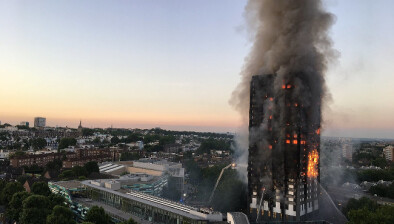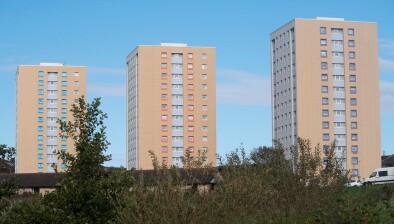Opinion: The Grenfell Inquiry and what it means for Scotland

Jane Fender-Allison and Douglas Morton
Following the tragedy at Grenfell Tower on 14 June 2017, the Grenfell Inquiry’s Final Report (also called the Phase 2 Report), was published in September. It paints a bleak picture of years of failures by government and others in the construction industry and calls for far-reaching reforms. In this article, Jane Fender-Allison and Douglas Morton from the Construction team at Burness Paull explore the Inquiry’s findings and recommendations in the Report and what they mean for Scotland.
Findings of the Grenfell Inquiry
The Final Report of the Grenfell Inquiry pulls no punches. It’s an in-depth analysis of the factors leading to the fatal fire, concluding this was “the culmination of decades of failure by central government and other bodies in positions of responsibility in the construction industry to look carefully into the danger of incorporating combustible materials into the external walls of high-rise residential buildings and to act on the information available to them”.
Government and organisation failures
The Report identifies systemic failures across government bodies, construction companies and fire safety organisations. It criticises the UK Government’s neglect in addressing the risks of combustible cladding materials, despite prior warnings. It finds regulation of the construction industry is too complex and fragmented, a “recipe for inefficiency and an obstacle to effective regulation”. It highlights failures by the Department for Communities and Local Government to act on known risks and maintain adequate fire safety standards. It scrutinises various certification bodies, their overseeing body and Local Authority Building Control, finding repeated failures to ensure accurate product certifications, allowing misleading claims and marketing for those products.
The Report also finds statutory guidance to be unsatisfactory. In particular, Approved Document B (the statutory guidance regarding building regulation in England covering fire safety matters within and around buildings), is described as poorly worded and liable to give a misleading impression that compliance with it is the same as compliance with the Building Regulations.
In short, the Report finds that “the system of regulating the construction and refurbishment of high-rise residential buildings that existed at the time of the Grenfell Tower fire was seriously defective in a number of respects”.
Design and product failures
The Report identifies numerous failures by the architect, fire engineer, principal contractor and cladding sub-contractor in the refurbishment of Grenfell Tower, where combustible materials were used for the cladding. The Report states that “None of those involved in the design of the external wall or the choice of materials acted in accordance with the standards of a reasonably competent person in their position. They were not familiar with or did not understand the relevant provisions of the Building Regulations, Approved Document B or industry guidance”, at a time when the risks of using combustible materials in external walls of high-rise buildings were well known.
Further, the Report finds systematic dishonesty by manufacturers and sellers of cladding and insulation products, which contributed to the use of combustible materials on Grenfell Tower.
The Report addresses issues raised in its earlier Phase 1 Report, such as the role of the ACM (aluminium composite material) panels and insulation boards in contributing to the rapid fire growth and the mechanism of fire escape. It also critiques the fire testing regime of the time, finding “In the years leading up to the Grenfell Tower fire test methods available for determining the reaction to fire of materials, products and even external wall systems did not provide designers with the information needed to assess the risk of fire spreading across the external wall of a building. Moreover, the statutory guidance on complying with functional requirement B4(1) of the Building Regulations was fundamentally defective”.
Local authority and fire service failures
The Report examines the roles of the Tenant Management Organisation at Grenfell Tower and the Royal Borough of Kensington and Chelsea, highlighting their inadequate fire safety management and poor relationship with residents. The London Fire Brigade is also criticised for its lack of preparedness and ineffective response, with deficiencies in training and communication.
The Report contrasts disorganised official responses, with the effective support provided by the local community and voluntary organisations in the aftermath of the tragedy.
Recommendations of the Final Report
The Report acknowledges developments since the Grenfell fire, such as the Building Safety Act 2022 (the “BSA”). However, unsurprisingly, the Inquiry makes comprehensive recommendations for building safety changes across the construction industry. The key recommendations, set out at Chapter 113 of the Report, include:
- Single construction regulator – That there should be a single independent body, reporting to a single Secretary of State, with functions across the construction industry. The regulator would have a wider remit than the Building Safety Regulator established under the BSA, including the regulation of construction products (as opposed to the more fragmented approach of a National Regulator for Construction Products under the BSA) and the licensing of principal contractors to work on higher-risk buildings. As well as the effective sharing of information, the Report considers a single construction regulator would be “a focal point in driving a much-needed change in the culture of the construction industry”.
- Single Secretary of State for fire safety and Chief Construction Adviser – Given “the fragmentation of responsibility for regulating the construction industry is currently mirrored in the range of government departments responsible for matters affecting fire safety”, that the government brings responsibility for the functions relating to fire safety (currently exercised by Ministry of Housing, Communities and Local Government, the Home Office and the Department for Business and Trade), into one department under a single Secretary of State. A further recommendation is the appointment of a Chief Construction Adviser, with sufficient budget and staff to provide advice on all matters affecting the construction industry.
- Change to the definition of “higher-risk building” under the BSA – The BSA’s definition of a higher-risk building refers mainly to the building’s height (at least 18m or 7 storeys, with at least two residential units). The Report recommends urgently reviewing the definition for the purposes of the BSA, to consider a focus on the nature of the building’s use and in particular, the likely presence of vulnerable people.
- Review of guidance under English Building Regulations – That the statutory guidance as to the Building Regulations generally (and in particular Approved Document B), be urgently reviewed (and kept under review) and a revised version published as soon as possible. The Report notes the need to include a clear warning in revised guidance, that legal requirements are contained in the Building Regulations and that compliance with the guidance will not necessarily result in compliance with them.
- Regulation of fire engineers – That the title and function of “fire engineer” should be formally recognised and protected by law. Further, that the profession and the conditions for membership should be regulated by an independent body for fire engineers, whilst the government and others should produce an authoritative statement of the knowledge and skills to be expected of a competent fire engineer.
- Mandatory fire safety strategy – That producing a fire safety strategy by a registered fire engineer, taking into account the needs of vulnerable people, should be a statutory requirement. It would be submitted with building control applications at BSA Gateway 2 for the construction or refurbishment of any higher-risk building, then reviewed and re-submitted at completion at BSA Gateway 3.
- Licensing and mandatory statement from principal contractors –That a licensing scheme for principal contractors wishing to undertake construction or refurbishment of higher-risk buildings, be operated by the construction regulator. Plus making it a legal requirement for a personal undertaking from a director or senior manager of the principal contractor, to take all reasonable care to ensure that on completion and handover the building is as safe as is required by the Building Regulations, to be submitted with a BSA Gateway 2 application.
- Mandatory statement from principal designer – Similarly, to introduce a legal requirement for a statement from a senior manager of the principal designer under the BSA, that all reasonable steps have been taken to ensure on completion the building as designed will be as safe as is required by the Building Regulations, to be submitted at BSA Gateway 2.
Other recommendations include developing new fire performance test methods; establishing a system to certify the competence of fire risk assessors; reviewing the government’s powers under the Civil Contingencies Act 2004 when a “Category 1 Responder” fails to rise to the challenge; increased resilience training within local authorities; creating a College of Fire and Rescue to set national standards and improve training and education within fire services; and providing better emergency response and recovery planning, particularly for vulnerable residents in high-rise buildings.
What this means for Scotland
The Inquiry has naturally focussed on the position in England, where the Grenfell Tower tragedy occurred and there is little specific mention of Scotland in the Report. Whilst many of the technical requirements in construction projects are applicable across England and Scotland, there are important differences, including those arising from legislation made by the Scottish Parliament as a devolved legislature. Particularly relevant to building safety, are the separate systems of Building Regulations in Scotland (made under the Building (Scotland) Act 2003) and England (made under the Building Act 1984, which does not apply in Scotland). The BSA in turn focuses on England and Wales. Only certain provisions apply in Scotland, mainly relating to construction products and liability; costs contribution orders; the new homes ombudsman; and architects’ regulation.
That said, the gravity of the issues seen at Grenfell Tower make them relevant throughout the UK. The BSA, the wider focus on building safety and the push to effect cultural change in the construction industry, have all had a ripple effect in Scotland. It remains to be seen how many of the Inquiry’s recommendations will be taken forward. Currently the UK Government has promised a full response within six months. However, those and other measures which may be progressed, could see implementation across the UK.
Scotland’s building safety regime
Meanwhile, Scotland has progressed its own building safety measures over recent years, including:
- Ministerial Working Group – Immediately after the Grenfell Tower fire, the Scottish Government set up a Ministerial Working Group on Building and Fire Safety, including ministers, government officials and representatives from the fire service and building control. A letter from the Scottish Housing Minister on the day of the Report’s publication, also confirmed that the Scottish Government is considering any further action required to address building safety, in response to the Report.
- Cladding Remediation Programme – This programme was established by the Scottish Government, to “improve the safety of residents and owners by addressing the risk to human life that is (directly or indirectly) created or exacerbated by a building’s external wall cladding system, in multi-residential domestic buildings (which may include commercial premises) constructed or refurbished between 1 June 1992 and 1 June 2022, 11 metres and over in height and incorporating a form of external wall cladding system”. It uses Single Building Assessments introduced in March 2021 (“SBAs”), carried out on a building-by-building basis, to identify life critical fire safety risks and any mitigation or remediation required to move a building to low risk. SBAs were initially piloted in a programme by the Scottish Government, focussing on high priority buildings.
- Scottish Advice Note –In August 2021 the Scottish Government published a Scottish Advice Note, aiming to assist in determining the fire risk posed by external wall systems. It was updated in December 2022, to include guidance on how to carry out a fire safety assessment as part of the SBA programme.
- Scottish Safer Buildings Accord and development commitment letter – In May 2022 the Scottish Government announced its intention to achieve a safer buildings “Accord” with developers to address the issue of combustible cladding, similar in scope to the Developer Pledge in England. This led to the creation of a proforma “development commitment letter” in 2023. So far, nine developers have issued such letters. The Scottish Government intends to negotiate a long-form contract with them to address the cladding issues, akin to the developer remediation contract in England.
- Combustible cladding ban –In June 2022, amendments to the Scottish Building Regulations banned (1) the use of combustible external wall cladding on high-risk buildings over 11 metres and (2) the use of highly combustible metal-composite cladding, such as that used in Grenfell Tower, on any buildings.
- Housing (Cladding Remediation) (Scotland) Act 2024 – This flagship Act was introduced to facilitate the delivery of the Cladding Remediation Programme. (See our previous blogs on the legislation here). It creates a statutory basis for the SBAs (with a technical specification for SBA methodology published in June 2024 and further standards to follow) and provides for a Cladding Assurance Register, which will contain information about SBAs carried out and what remedial work if any has been completed. The Act also provides for a responsible developers scheme to be created to: “secure that persons in the building industry address, or contribute towards the costs of addressing, risks to human life created or exacerbated (directly or indirectly) by the external wall cladding systems of buildings that are wholly or partly residential”. The majority of the Act is still to be brought into force and the details of how the responsible developers scheme will operate are to be developed through further consultation and secondary legislation.
Next steps
Now the publication of the Final Report has brought a renewed focus to building safety, throughout the UK. This sits with the Scottish Government’s recently published 2024 / 2025 legislative programme, which highlights plans for “accelerating progress on cladding, commencing the newly passed Housing (Cladding Remediation) (Scotland) Act, delivering assessment, risk mitigation and remediation measures in affected properties on a prioritised basis”, plus the potential introduction of a Scottish Building Safety Levy, to provide “vital revenues” to support funding of the Cladding Remediation Programme.
This was swiftly followed on 23 September by the launch of a Scottish Government consultation about such a levy, aiming to ensure developers’ contributions to remediation works by way of an additional charge on new residential developments. It anticipates that a Scottish Building Safety Levy would mirror measures introduced in England through the BSA and could raise £30 million annually, with implementation expected by April 2026. Feedback is sought on various aspects, including potential exemptions and reliefs (e.g. for affordable housing and small developments or developers) and calculation methods (e.g. based on property market values, sizes or other options).
We can expect to see this and other significant building safety developments continue in Scotland and the UK, in the coming years.








